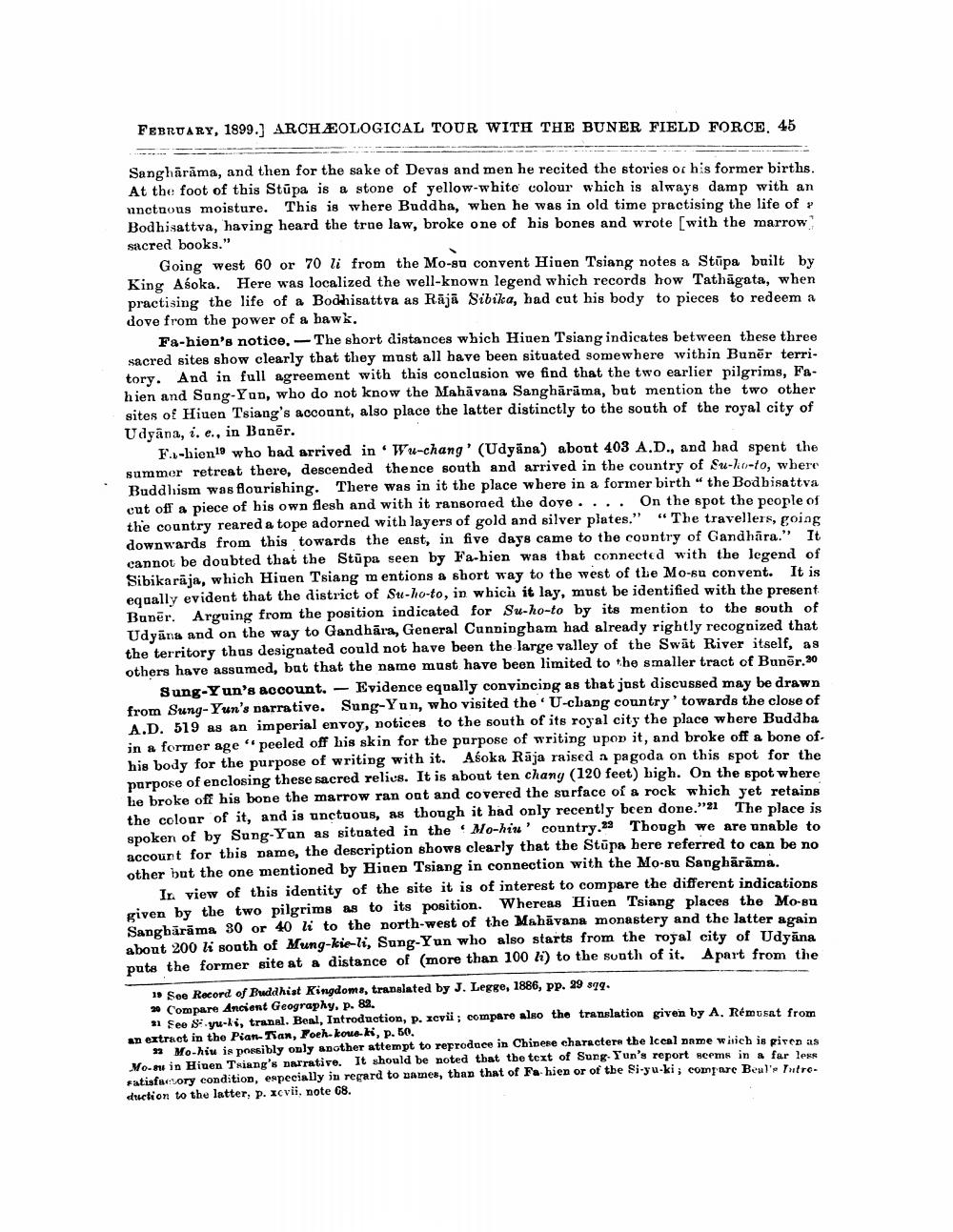________________
FEBRUARY, 1899.] ARCHEOLOGICAL TOUR WITH THE BUNER FIELD FORCE. 45
Sanghārama, and then for the sake of Devas and men he recited the stories or his former births. At the foot of this Stupa is a stone of yellow-white colour which is always damp with an unctnous moisture. This is where Buddha, when he was in old time practising the life of Bodhisattva, having heard the true law, broke one of his bones and wrote [with the marrow sacred books."
Going west 60 or 70 li from the Mo-su convent Hiuen Tsiang notes a Stupa built by King Aśoka. Here was localized the well-known legend which records how Tathāgata, when practising the life of a Bodhisattva as Rājā Sibika, had cut his body to pieces to redeem a dove from the power of a hawk.
Fa-hien's notice. The short distances which Hiuen Tsiang indicates between these three sacred sites show clearly that they must all have been situated somewhere within Buner territory. And in full agreement with this conclusion we find that the two earlier pilgrims, Fahien and Sung-Yun, who do not know the Mahavana Sanghārama, but mention the two other sites of Hiuen Tsiang's account, also place the latter distinctly to the south of the royal city of Udyana, i. e., in Baner.
F.-hien19 who had arrived in Wu-chang' (Udyana) about 403 A.D., and had spent the summer retreat there, descended thence south and arrived in the country of Su-ho-to, where Buddhism was flourishing. There was in it the place where in a former birth "the Bodhisattva cut off a piece of his own flesh and with it ransoraed the dove. . . . On the spot the people of the country reared a tope adorned with layers of gold and silver plates." "The travellers, going downwards from this towards the east, in five days came to the country of Gandhara." It cannot be doubted that the Stupa seen by Fa-hien was that connected with the legend of Sibikarāja, which Hiuen Tsiang mentions a short way to the west of the Mo-su convent. It is equally evident that the district of Su-ho-to, in which it lay, must be identified with the present Buner. Arguing from the position indicated for Su-ho-to by its mention to the south of Udyana and on the way to Gandhara, General Cunningham had already rightly recognized that the territory thus designated could not have been the large valley of the Swat River itself, as others have assumed, but that the name must have been limited to the smaller tract of Buner.20 Sung-Yun's account. Evidence equally convincing as that just discussed may be drawn from Sung-Yun's narrative. Sung-Yun, who visited the U-chang country' towards the close of A.D. 519 as an imperial envoy, notices to the south of its royal city the place where Buddha in a former age "peeled off his skin for the purpose of writing upon it, and broke off a bone of. his body for the purpose of writing with it. Aśoka Rāja raised a pagoda on this spot for the purpose of enclosing these sacred relics. It is about ten chang (120 feet) high. On the spot where he broke off his bone the marrow ran out and covered the surface of a rock which yet retains the colour of it, and is unctuous, as though it had only recently been done." The place is spoken of by Sung-Yun as situated in the Mo-hiu' country.23 Though we are unable to account for this name, the description shows clearly that the Stupa here referred to can be no other but the one mentioned by Hinen Tsiang in connection with the Mo-su Sanghārāms.
—
In view of this identity of the site it is of interest to compare the different indications given by the two pilgrims as to its position. Whereas Hiuen Tsiang places the Mo-su Sanghārama 30 or 40 li to the north-west of the Mahāvana monastery and the latter again about 200 li south of Mung-kie-li, Sung-Yun who also starts from the royal city of Udyana puts the former site at a distance of (more than 100 l) to the south of it. Apart from the
19 See Record of Buddhist Kingdoms, translated by J. Legge, 1886, pp. 29 sqq.
20 Compare Ancient Geography, p. 82.
21 Fee Syu-ki, tranal. Beal, Introduction, p. xcvii; compare also the translation given by A. Rémusat from an extract in the Pian-Tian, Foeh-koue-ki, p. 50.
22 Mo-hiu is possibly only another attempt to reproduce in Chinese characters the local name which is given as Mo-su in Hiuen Tsiang's narrative. It should be noted that the text of Sung-Yun's report seems in a far less Fatisfactory condition, especially in regard to names, than that of Fa-hien or of the Si-yu-ki; compare Beal's Intreduction to the latter, p. xcvii, note 68.




